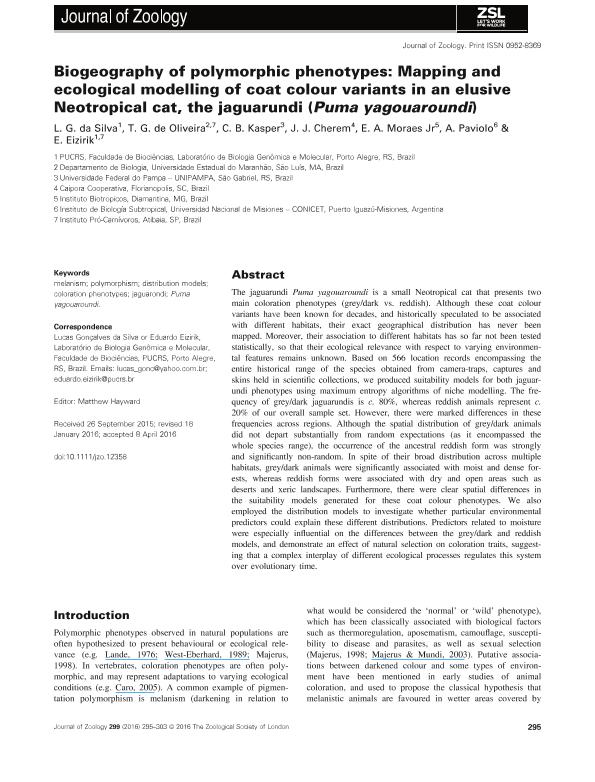Artículo
Biogeography of polymorphic phenotypes: Mapping and ecological modelling of coat colour variants in an elusive Neotropical cat, the jaguarundi (Puma yagouaroundi)
Gonçalves da Silva, Lucas; Gomes de Oliveira, Tadeu; Kasper, Carlos Benhur; Cherem, Jorge José; Moraes Jr., Edsel Amorim; Paviolo, Agustin Javier ; Eizirik, Eduardo
; Eizirik, Eduardo
 ; Eizirik, Eduardo
; Eizirik, Eduardo
Fecha de publicación:
08/2016
Editorial:
Wiley Blackwell Publishing, Inc
Revista:
Journal Of Zoology
ISSN:
0952-8369
e-ISSN:
1469-7998
Idioma:
Inglés
Tipo de recurso:
Artículo publicado
Clasificación temática:
Resumen
The jaguarundi (Puma yagouaroundi) is a small Neotropical cat that presentstwo main coloration phenotypes (grey/dark vs. reddish). Although these coat colour variants have been known for decades, and historically speculated to be associated with different habitats, their exact geographic distribution has never been mapped. Moreover, their association to different habitats has so far not been tested statistically, so that their ecological relevance with respect to varying environmental features remains unknown. Based on 566 location records encompassing the entire historical range of the species obtained from camera-traps, captures and skins held in scientific collections, we produced suitability models for both jaguarundi phenotypes using maximum entropy algorithms of niche modelling. The frequency of grey/dark jaguarundis is ca. 80%, while reddish animals represent ca. 20% of our overall sample set. However, there were marked differences in these frequencies across regions. Although the spatial distribution of grey/dark animals did not depart substantially from random expectations (as it encompassed the whole species range), the occurrence of the ancestral reddish form was strongly and significantly non-random. In spite of their broad distribution across multiple habitats, grey/dark animals were significantly associated with moist and dense forests, while reddish forms were associated with dry and open areas such as deserts and xeric landscapes. Furthermore, there were clear spatial differences in the suitability models generated for these coat colour phenotypes. We also employed the distributionmodels to investigate whether particular environmental predictors could explain these different distributions. Predictors related to moisture were especially influential on the differences between the grey/dark and reddish models, and demonstrate an effect of natural selection on coloration traits, suggesting that a complex interplay of different ecological processes regulates this system over evolutionary time.
Archivos asociados
Licencia
Identificadores
Colecciones
Articulos(IBS)
Articulos de INSTITUTO DE BIOLOGIA SUBTROPICAL
Articulos de INSTITUTO DE BIOLOGIA SUBTROPICAL
Citación
Gonçalves da Silva, Lucas; Gomes de Oliveira, Tadeu; Kasper, Carlos Benhur; Cherem, Jorge José; Moraes Jr., Edsel Amorim ; et al.; Biogeography of polymorphic phenotypes: Mapping and ecological modelling of coat colour variants in an elusive Neotropical cat, the jaguarundi (Puma yagouaroundi); Wiley Blackwell Publishing, Inc; Journal Of Zoology; 299; 4; 8-2016; 295-303
Compartir
Altmétricas



